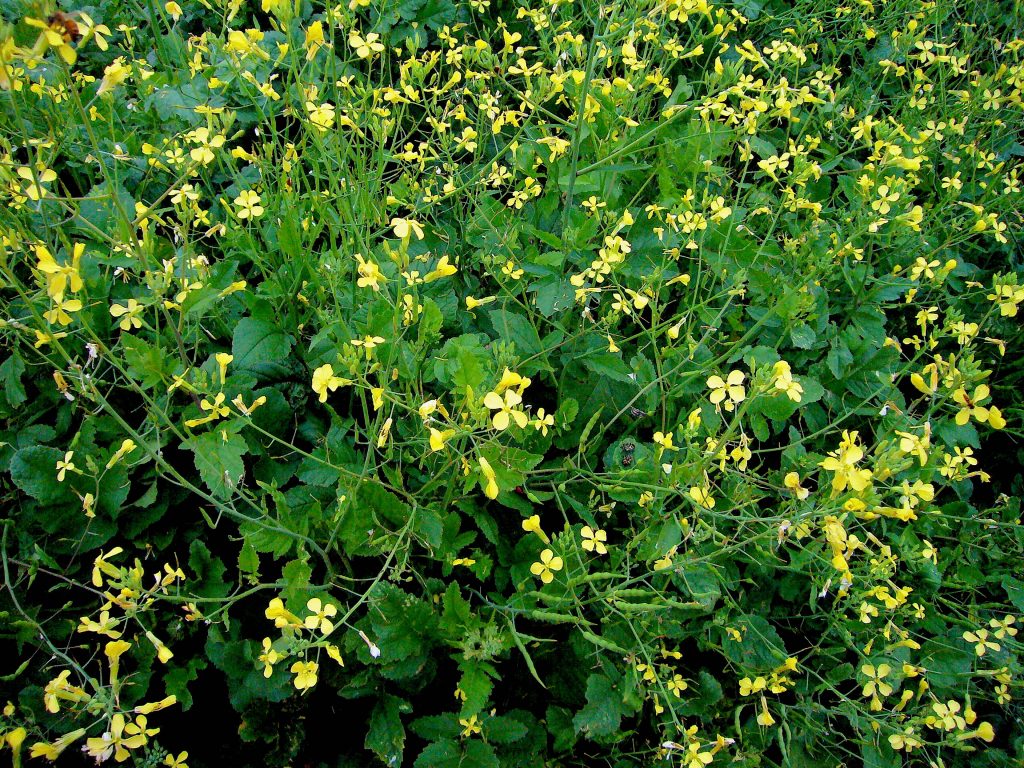
Wild Radish and Mustard are in blossom now. Photo by Green Deane
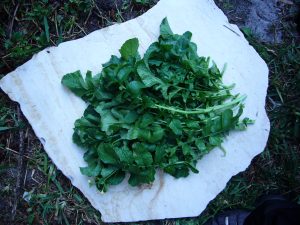
Wild Mustard greens on white marble. Photo by Green Deane
Mustards like chilly weather, or at least locally they do. You can see Wild Mustards and Wild Radish not only along roadsides now but in various fields from farm land to ignored citrus groves. The two species are used interchangeably and look similar. However Wild Radishes tend to be serpentine rather than straight and tall like Wild Mustard. They also have lumpy seed pods, or, more lumpy than mustard seed pods. Usually you will find a stand of one or the other. I don’t recall finding both in the same patch. Blossom colors can range from yellow to white with streaks of purple. But the leaves always have the biggest lobe on the end farthest from the plant. Look for them in sunny areas with fertile soil. Not native they came from Eurasia in the 1700s. And note the seeds can remain viable in the soil for up to 60 years. To read more Wild Radish go here, and for Wild Mustard, here. I have a video on wild radish here, wild mustard here.
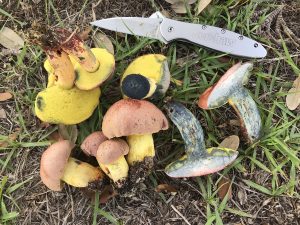
Edible “Ruby” Boletes. Photo by Green Deane
Seasonal rains have been… well… unseasonal. Rain over the past week forced out a lot of species of terrestrial mushrooms often seen at other times of the year. A local hike produced hundreds of the pretty lavender but non-edible Cortinarius iodes. There should be some similar looking edible Clitocybe/Lepista nuda but I have not seen any of those yet. What was also up is a local edible bolete with a 10-syllable name: Pulchroboletus rubricitrinus. The species name used to be shorter until DNA testing came along and got it reclassified. Many locals just call them “Rubies.” Pulchroboletus rubricitrinus (pull-crow-bow-LEET-us roo-bree-sit-TRIN-us) means Pretty Lump Red/Lemon Yellow or Pretty Clump Red/Lemon Yellow. Bolete is from Dead Latin Boletus which is from the Greek βωλίτης, bow-LEE-tis, which is from βῶλος, BOW-los meaning lump or ‘clod. “Latin” is usually just bastardized Greek and/or Etruscan.
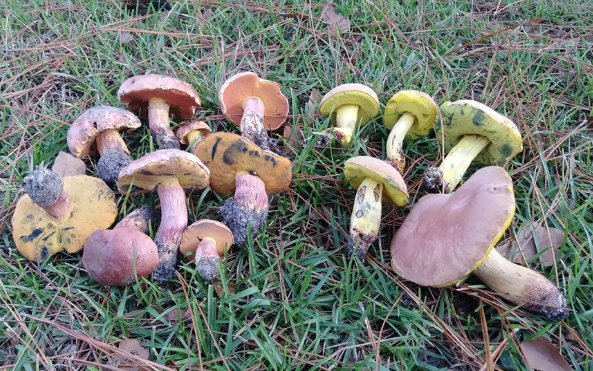
Butter Bolete is on our left, Ruby on our right.
While it is something of a debate it seems most Boletes in Florida are edible cooked unless you don’t like the flavor or the aroma. Some gray Boletes, however, might cause gasto-intentional distress. But, it is agree they are not life-threatening to healthy people. A basic problem with “Rubies” is they look similar to another Bolete with a long-winded name: Butyriboletus floridanus (Beu-tree-ee-bow-LEE-tus flor-ree-DAY-nus) or Butter Lump Florida. And to make it a bit confusing the one with “butter” in it’s name is not buttery yellow but more orange. See the photo by David Raney, left. The Butter Bolete is on our left, the Ruby on our right. The Butter has more orange/red pores and most of the stem is pink/red wtih netting. The Ruby has more yellow stem and pores and tends to have red at the base of the stem, yellow higher, and no netting. Both stain blue/blue-green when bruised. The Ruby has a slightly acid flavor, the Butter has a strong acid tang. There are no Boletus bicolors in Florida which resembles the Ruby.

Foraging classes are held rain or shine, heat or cold.
Foraging Classes: It was lovely weather for our foraging class in Port Charlotte last week. It might be a little rainy for our Winter Park class this Saturday but should warm up and be nice for our class in West Palm Beach Sunday.
Saturday, January 4th, Mead Garden, 1500 S. Denning Dr., Winter Park, FL, Meet by the restrooms. 9 a.m. to noon. (Don’t confuse this with Ft. Meade which is a different location above.)
Sunday, January 5th, Dreher Park, 1200 Southern Blvd., West Palm Beach, 33405. Meet just north of the science center. 9 a.m. to noon.
Saturday, January 11th, Colby-Alderman Park: 1099 Massachusetts Street, Cassadaga. Fla. 32706. 9 a.m. to Noon. Meet at the restrooms.
Sunday, January 12th, John Chestnut County Park: 2200 East Lake Road, Palm Harbor, FL 34685. 9 a.m. to noon. Meet at the beginning of the Peggy Park Trail inside John Chestnut Park. That is on the extreme south end of the park.
To read more about the classes go here.
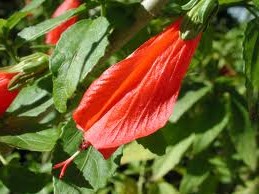
This hibiscus blossoms never opens.
We saw several species blooming this past weekend in my foraging class. The Hibiscus were happy including the “Sleepy Hibiscus.” It’s a fairly easy shrub to identify because the bright red blossoms never unfurl. Also blossoming was the Bauhinia. It’s a tree that is both easy and challenging at the same time. The blossoms are edible, look nice in salads. Some of the species have edible seeds and some do not. (They are in the pea family and most pea trees — most not all — do not have edible seeds.) Sorting out which Bauhinia you have can be a challenge, nearly as bad as sorting out which Cereus you have. Like the Cereus cactus there are several man-made hybrids and perhaps even some fake botanical names. It can make species identification a real headache though as far as I know all the blossoms are edible. Only “discovered” 111 years ago the blossom of the Bauhinia blakeana is the emblem of Hong Kong. You can read about the Bauhinia here.
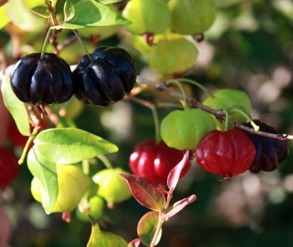
Surinam Cherries have eight ribs.
This newsletter has mentioned in previous editions this fall how many species have been blooming out-of-season perhaps because of unusual rain patterns. As in previous classes we saw some grapes blossoming in early December when they should be setting in the spring. But perhaps the most out-of-season display was Surinam Cherries last week. I had Suriname Cherries in my yard for many years. They are indeed a springtime fruit though occasionally one or two fruit would pop up at the end of summer. This time, however, there was a lot of ripe fruit which the foraging class enjoyed. It was also an opportunity for me. I rarely see Black Suriname Cherries and think they have a superior flavor. But I’ve had a hard time starting them from seeds. This time I got a lot of seeds to try and it gives me a head start on spring. To read about the Suriname Cherry go here
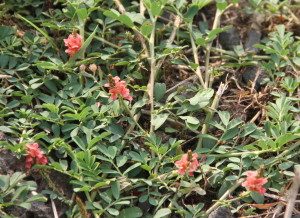 Veterinarians annually issued a warning about a plant that is makes horses sick locally, Creeping Indigo, Indigofera spicata. Cold weather causes this pea relative to blossom pink, making it a little easier to see. Unfortunately it is a plant favored by horses with at least one dying and others sickened. (This highlights that relying on instinctual means to avoid toxic plants is not too reliable for animals or man.) As with many toxic and invasive species Creeping Indigo was intentionally brought to Florida in 1925. The University of Florida imported it from Sri Lanka (then Ceylon) for agricultural experiments. When it killed one of two rabbits the testing stopped but the weed stayed (the second rabbit recovered after the Creeping Indigo was removed from its diet.) Within eight years Creeping Indigo was raising concerns about poisoning farm animals.
Veterinarians annually issued a warning about a plant that is makes horses sick locally, Creeping Indigo, Indigofera spicata. Cold weather causes this pea relative to blossom pink, making it a little easier to see. Unfortunately it is a plant favored by horses with at least one dying and others sickened. (This highlights that relying on instinctual means to avoid toxic plants is not too reliable for animals or man.) As with many toxic and invasive species Creeping Indigo was intentionally brought to Florida in 1925. The University of Florida imported it from Sri Lanka (then Ceylon) for agricultural experiments. When it killed one of two rabbits the testing stopped but the weed stayed (the second rabbit recovered after the Creeping Indigo was removed from its diet.) Within eight years Creeping Indigo was raising concerns about poisoning farm animals.
Besides horses, it is also toxic to cattle, sheep, goats, guinea pigs, rabbits, and birds. Pigs won’t eat it which calls into question reports that it does not bother pigs. Someone might be assuming that since pigs aren’t being reported sick from eating Creeping Indigo they aren’t bothered by it whereas it could equally be that because pigs avoid it there are no reports porcine poisoning. The prime toxin in Indigofera spicata is indospicine which “inhibits the incorporation of arginine and other amino acids in liver cells result in liver insufficiency.”
Happy New Year! This is weekly newsletter 386, If you want to subscribe to this free newsletter you can find the sign-up form in the menu at the top of the page.
To donate to the Green Deane Newsletter click here.


How cool is this… I was out for a stroll and came across a massive patch of boletes, and grabbed one to identify. I come in the house, get on the computer, and lo and behold, there it is in all it’s glory in this very issue of the newsletter! This one is pretty buggy, but what else do I need to know before tasting one so I don’t get sick or kill myself? LOL
I’ve been in a hospital a few times over the last 3 years that serves steamed bauhinia blossoms with its green beans. I don’t remember how they tasted as I had other things on my mind right then.